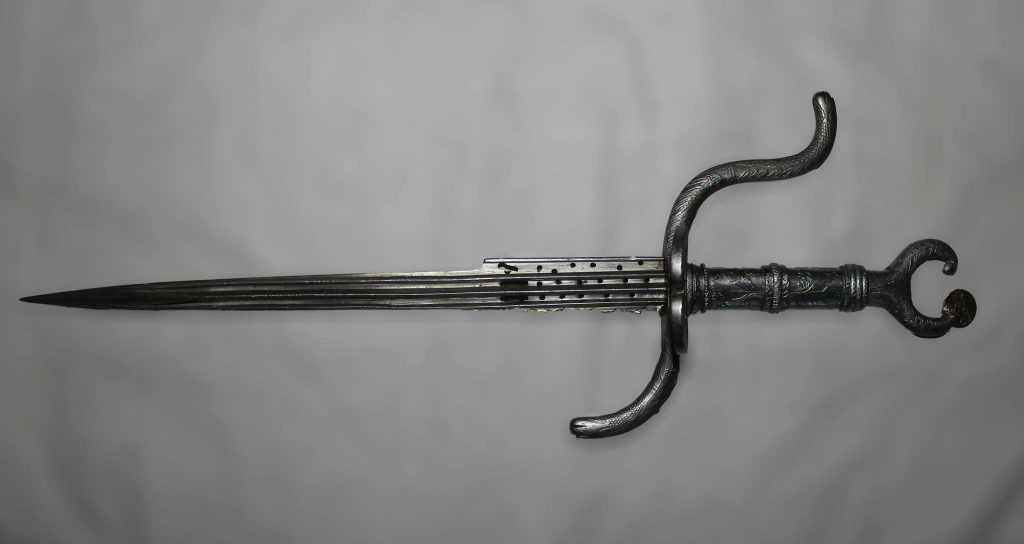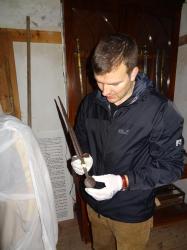The Schwarzburg Armoury (2): The Main-Gauche Dagger (Oss 2825)
Feb 26, 2018 Konrad Kessler All Posts, Combat Archaeology 0
Introductory note:
In May 2018 – almost 100 years after the abdication of the last prince of the house of Schwarzburg – the Schwarzburger Zeughaus, the armoury of the Schwarzburg castle, is to be re-opened to visitors. It will be presenting a unique collection of arms and armour of over 4000 objects which have accumulated over a period of 500 years and date as far back as the Late Middle Ages. Mentioned in historical sources as early as the 14th century, the Schwarzburger Zeughaus is the oldest and only surviving princely armoury collection in Germany. As such, the collection, which is to be on display in the original freestanding building, is an exceptional source of information on historical weaponry and warfare in Europe. In this series of blog posts, I will present a few of the main pieces of the collection which I examined as the main researcher for the Armouries catalogue.
The Main-Gauche Dagger (Oss 2825)

Main-gauche (Oss 2825) in Schwarzburger Zeughaus, the armoury of the Schwarzburg castle (photo: Konrad Kessler)
Short description: Iron hilt with remnants of a gold swap. Antenna-shaped pommel. Full metal grip with tulips-decor and decorated ring bands. S-shaped quillons with snakehead ends and parry-ring. Point with barb hooks.
Origin: Italian
Manufacturer: Unknown
Dating: 2nd half of the 17th century
Main-gauche – left-hand daggers are typical weapons of the late 16th and 17th century, constituting part of a set together with a sword or a rapier. Main-gauches served two fundamental functions. As short and often expensively decorated weapons, they were worn as symbols of wealth and power. At the same time, they were efficient side-arms used with the left hand. They assisted the longer main weapon in the right hand in parrying attacks but were also used for trusts at shorter distances.
Oss 2825 is an extraordinary weapon in multiple ways. The dagger is impressive in design with its unusual hilt design, especially the antenna-like pommel, which is similar to those found on certain bronze swords and daggers of the Late Bronze Age and Early Iron Age. Another special feature of the daggers is the four-edged point with two barb hooks. This gives the blade a particularly dangerous appearance. In addition to appearances, their function was to provide a short-term binding of the opponent’s blade. [In successful thrusts, the barb hooks would also entail greater bodily harm when the dagger was removed, tearing out flesh in the process and causing more bleeding.] Interestingly, the dagger was the weapon of a left-hander. The shape of the bending direction of the quillons in combination with the parry-ring only allows a use it with the right hand.
Dimensions
Total length: 458 mm
Blade length: 310 mm
Blade width: 30 mm
Guard rod length: 165 mm
Weight: 915 g
Material Blade: Steel
Hilt: Iron, gold
To learn more about Combat Archaeology Click Here.
- archaeology, armory, armour, armoury, arms, barb hooks, bronze age, combat, combat archaeology, dagger, early modern, fencing, fighting, Germany, grossmesser, hallstatt, kessler, konrad, main-gauche, medieval, messer, middle ages, nagel, parrying, princely, renaissance, Schwarzburg, society for combat, sword, swords

Konrad Kessler
Konrad holds an MA degree in Modern History. He studied in Jena, Germany, and Leiden, Netherlands. He has published several books on castles in Germany and Israel as well as on sword fighting. Lately, Konrad had done a major research project on the weapons in the Schwarzburg Armory. From his childhood on Konrad has been fencing and for the last 20 years focusing on longsword and dagger fighting. He is the Head of the German section of KDF International and a senior instructor in Historical Weapons Combat. He has been teaching at national as well as international events and gives a regular course at the University Sports Centre of the University of Applied Sciences Jena.
Related articles
-
 Online lecture: The Five Ships from...
Online lecture: The Five Ships from...Mar 06, 2024 0
-
 Online Lecture: ‘The Physiology...
Online Lecture: ‘The Physiology...Apr 19, 2023 2
-
 Get involved!
Get involved!Mar 20, 2023 0
-
 The Loss of the King’s flagship...
The Loss of the King’s flagship...Nov 22, 2020 0
More in this category
-
 New Member of Combat Archaeology: Dean...
New Member of Combat Archaeology: Dean...Sep 22, 2016 0
-
 New Member of Combat Archaeology: Claes...
New Member of Combat Archaeology: Claes...Dec 01, 2015 0
-
 The Case of Refshaleborg Castle
The Case of Refshaleborg CastleMay 26, 2015 0
-
 XV Nordic TAG 2015 CALL FOR PAPERS
XV Nordic TAG 2015 CALL FOR PAPERSJan 13, 2015 1








